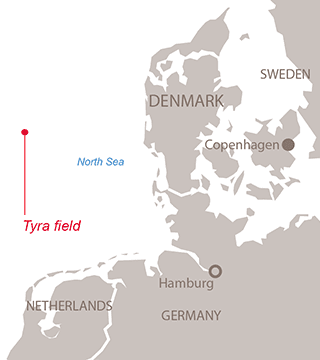KeyFacts Energy: Total Denmark country profile l Noreco Denmark country profile

Norwegian Energy Company today announced that the three Tyra East wellhead and riser platforms have arrived safely at the Tyra field in Denmark.
Earlier this summer HTV (Heavy Transport Vessel) BigRoll Beaufort sailed from the Sembcorp Marine construction yard in Singapore with the three topsides, headed directly to the Tyra field. The 16.000 kilometers long voyage went according to plan and schedule. At the Tyra field, the world’s largest crane vessel, Sleipnir, is now in position to lift the three topsides off the vessel and onto the jackets. The lifting of the topsides will be followed by an installation period scheduled to take place during September. Progress on the five remaining platforms continues per schedule to meet the first gas date in Q2 2023.
Rebuilding and revitalizing Tyra
The original Tyra platform started production in 1984 and has since been complimented by several satellite platforms. However, due to subsidence, redevelopment is necessary. Subsidence is a natural consequence of continuously extracting oil and gas from gas fields over decades.
That extraction causes the hydrocarbon pockets in those gas fields to collapse and the seabed to sink. The seabed below the Tyra platforms has sunk nearly five meters since 1984.
As a result, the gap between the sea and the Tyra platforms’ decks was reduced. This reduction ultimately means redevelopment is necessary to keep both crew and equipment safe, as well as keep production efficient.
The execution of Tyra's redevelopment project is both a global and local effort. In addition to fabricating installations in both Europe and Asia, project efforts are being executed locally in Esbjerg, and offshore in the Danish North Sea.
The redevelopment project started in 2018, with the first steel cut on the new platforms. Following a safe and well-executed offshore campaign, the Tyra field’s production was temporarily suspended in September 2019 to allow the next steps in the redevelopment project to take place.
The unique scope of work for Tyra's redevelopment project includes removing old facilities, modifying existing ones, and installing new features.
The two existing process and accommodation platforms will be replaced by one new process platform and one new accommodation platform. The four wellhead platforms and two riser platforms will have their jackets extended by 13 meters, and the current topsides will be replaced.

A high-tech field for the future
The new Tyra will be a state-of-the-art facility ensuring efficient production and enhanced safety. With the use of new technology and modernized working processes, TotalEnergies anticipates that Tyra’s operational efficiency will increase from its current average of around 80% to more than 90% after launching.
These new technologies and methodologies will be integrated with the redeveloped Tyra platforms:
- Sensors that continuously collect data about critical equipment from around 100,000 data points.
- Digital and online tools to monitor performance and improve maintenance.
- Handheld digital devices for offshore employees to have constant access to systems, data, drawings, etc., as well as onshore specialist support.
- Big data and shared data availability for both onshore and offshore staff to foster better collaboration, understanding and analytics.
Located in the Danish North Sea, Tyra gas field is being redeveloped with an investment of kr22.3bn ($3.36bn) to extend its operational life by at least 25 years.
This investment is the biggest ever made in the Danish North Sea.
Total E&P Danmark (Total) (43.2%), Noreco (36.8%) and Nordsofonden (20%) operate the Danish Underground Consortium (DUC).
 KEYFACT Energy
KEYFACT Energy